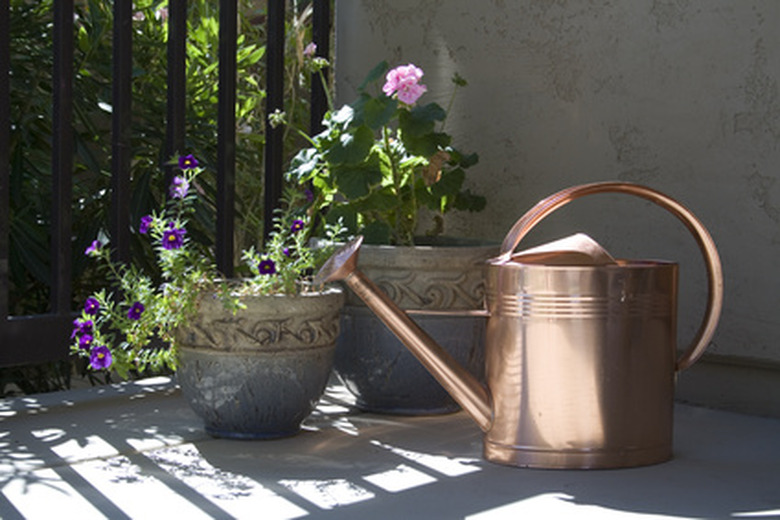What Plants Are Native To Germany?
In 2003, two garden culture professors in Germany contributed to an article called "The Native Plant Enthusiasm: Ecological Panacea or Xenophobia?" Its content started a country-wide debate about the importance of using only native plants in gardening; as of 2010, the debate raged on. To play it safe while gardening in Germany, use the most desirable of these natives.
Boraginaceae
There are 2,000 species in this plant family, both perennials and annuals; many are woody plants, most are herbs. Some of the most familiar are Mysotsis's Forget-Me-Nots. They typically have hairy stems and bloom in white, yellow, blue and purple. Other borage family members include Anchusa officinalis, Borago officinalis, Buglossoides arvensis, Cynoglossum officinale, Echium vulgare, Lithospermum officinale, Mysotis ramosissima, Myosotis sylvatica and Pulmonaria officinalis.
Lamiaceae
This is the mint family, but is not known to be the friendly one in all cases; it includes delicious thyme, basil and sage, as well as nasty nettles. It also includes ornamental coleus and a few undesirable weeds. Flowers in this group are usually shaped very much like small snapdragon blooms and are mostly white and yellow. Other members of the family are Acinos arvensis, Ajuga genevensis and reptans, Ballota nigra, Clinopodium vulgare, Galeobdolon luteu, Galeopsis ladanum, Glechoma hederacea, a number or Lamiums (album, amplexicaule, maculatum and purpureum), Lycopus europaeus, Mentha aquatic, arvensis, and longifolia, Ocimum basilicum, Origanum vulgare, Prunella vulgaris, Salvia pratensis, Scutellaria galericulata, Stachys palustris and recta, and Thymus marschallianus and pulegioides.
- In 2003, two garden culture professors in Germany contributed to an article called "The Native Plant Enthusiasm: Ecological Panacea or Xenophobia?" This is the mint family, but is not known to be the friendly one in all cases; it includes delicious thyme, basil and sage, as well as nasty nettles.
Malvaceae
One thousand species strong, the mallow family is best known for producing cotton. Ornamental hollyhock and hibiscus are also in the mallow clan. This family is characterized by large flowers in almost every botanical color and hairy seeds. Native German Malvaceae are Malva alcea, neglecta and sylvestris.
Oleaceae
This family contains 600 species of woody shrubs and climbers, as well as trees. Many are ornamental and have commercial uses; olives are in the Oleaceae family. Ligustrum vulgare, better known as the European privet, is Germany's native Oleaceae.
- One thousand species strong, the mallow family is best known for producing cotton.
Orobanchaceae
Known as the broom rape or broomrape family, this group has 2,000 species and is composed mostly of shrubs and herbs. These plants often have brownish or reddish leaves and flowers from yellow through pink to purple. Euphrasia rostkoviana, Lathraea squamaria, Melampyrum pretense, Orobanche caryophyllacea and lutea, Pedicularis palustris and sylvatica, and Rhinanthus major and serotinus are all in this family.
Orchidaceae
Somewhat surprisingly, Germany has many native plants in the orchid family. There are 20,000 species of orchids worldwide; Germany's natives are Cephalanthera damasonium and rubra, Cypripedium calceolus, Dactylorhiza fuchsia, incarnate and majalis, Gymnadenia conopsea, Himantoglossum hircinum, Listera ovate, Ophrys apifera and holosericea, Orchis mascul, militaris, purpurea and tridentate, and Platanthera chlorantha.
Osmundaceae
Germany has one native in the royal fern family: Osmunda regalis. Ferns like damp habitats and re-seed themselves via spores.
- Known as the broom rape or broomrape family, this group has 2,000 species and is composed mostly of shrubs and herbs.
- There are 20,000 species of orchids worldwide; Germany's natives are Cephalanthera damasonium and rubra, Cypripedium calceolus, Dactylorhiza fuchsia, incarnate and majalis, Gymnadenia conopsea, Himantoglossum hircinum, Listera ovate, Ophrys apifera and holosericea, Orchis mascul, militaris, purpurea and tridentate, and Platanthera chlorantha.
Primulaceae
The Primrose family is characterized by flowers with deep, flute-like cups, often inverted. There are almost 1,000 members of this family; some are good for winemaking and others are poisonous. Shooting Stars are in this family, which typically has white, yellow and pink flowers. Members include: Anagallis arvensis, Glaux maritime, Hottonia palustris, Lysimachia nummularia, Lysimachia thyrsiflora and vulgaris, Primula elatior, farinose and veris, Samolus valerandi, and Trientalis europaea.
